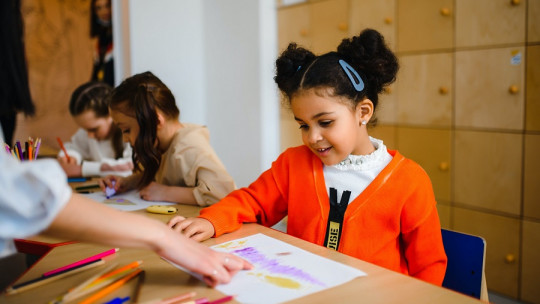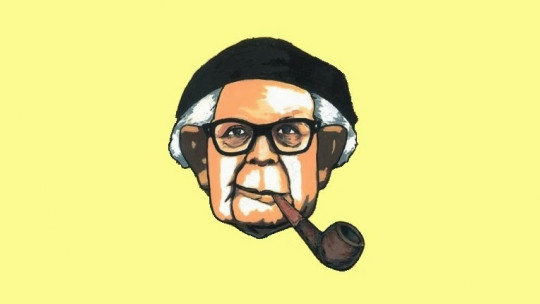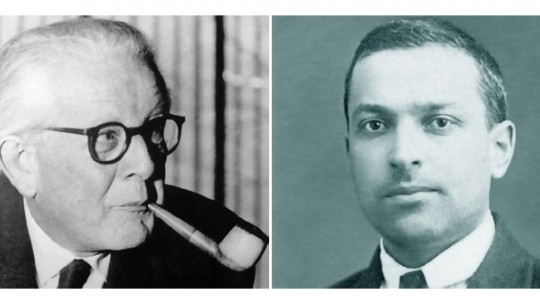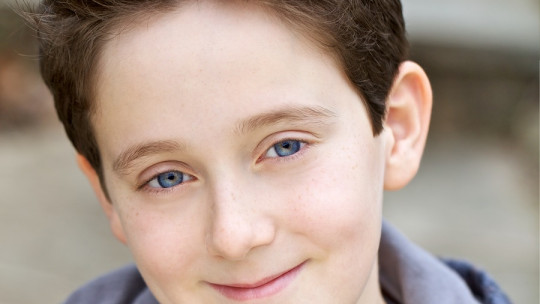
In his theory of cognitive development, Jean Piaget divided the growth of cognitive abilities in childhood into four stages: sensorimotor, preoperational, concrete operations, and formal operations.
Next we will focus on the preoperational stage, the second of them in which aspects such as a very egocentric vision, the beginnings of symbolic thinking and the belief that every object is alive stand out.
What is the preoperational stage?
The preoperational stage is a stage within Jean Piaget’s theory of cognitive development, succeeding the sensorimotor stage and coming before that of concrete operations and formal operations. This stage occurs between 2 and 6 years and its name is due to the fact that, when Piaget conceptualized it, He thought that children of that age were not capable of performing abstract mental operations their thinking being greatly influenced by how they perceived immediate things.
The preoperational stage presents a few achievements with respect to the sensorimotor stage. Among the most important are the fact that, as one would expect, cognitive abilities have been developing to such a point that the child has abilities such as making use of internal images, managing schemes, having language and using symbols, which will be fundamental in the development of self-awareness.
The main milestone of this stage is provide the child with greater representative knowledge, improving your communication and learning capacity. They begin to use persuasion tools to get what they want, such as toys or candy. However, not fully understanding logic, they are still not able to manipulate information in such a way as to ensure that their desire is satisfied or that other people see their point of view.
As the child grows, he experiences changes in the way he understands and captures ideas, while expressing them better. That is, he builds experiences about what happens around him, and progressively forms more coherent and logical thinking. Besides, They begin to be able to understand that something can represent something else, that is, the use of symbols begins causing objects to transform, momentarily, into something else (e.g., a spoon is an airplane).
It is called preoperational because the child is not yet able to use logic in such a way as to efficiently transform, combine or separate ideas. He does not understand concrete logic, which is why he is not able to manipulate information mentally and take other people’s point of view.
In the preoperational stage there are two substages.
1. Symbolic and preconceptual substage (2-4 years)
The child uses concrete images to understand the world, but does not acquire abstract or generalizable ideas yet Words have meaning based on your lived experience, not based on what has been explained to you without having been given a real example to represent it.
It uses preconceptions, which are closely linked to their sensory experience, which is why it is so important that children from 2 to 4 years old relate closely with nature to expand their world.
2. Intuitive or conceptual substate (4-7 years)
The child’s mind is dominated by immediate perception. Intuition plays a fundamental role in this stage since it involves the internalization of perceptions in the form of representative images that prolong sensorimotor schemes without rational coordination. That is, the child, based on what he has seen, intuitively dares to generalize what he already knows.
Characteristics of this stage
Jean Piaget attributed several characteristics to children who are in the preoperational stage.
1. Centering
Focusing is the infant’s tendency to concentrate on a single aspect of an object or situation at a time That is, children who are in this stage have problems thinking about more than one characteristic and taking them all into account simultaneously.
The opposite situation, that is, being able to shift your attention to another aspect, both of the same situation or object and of another, is decentration and, sooner or later, you acquire it.
Likewise, Your ability to decenter varies depending on the type of situation It is easier for them to change the focus of attention in non-social situations than in those that are social.
2. Egocentrism
Children’s thinking and communication at this stage is typically egocentric. By egocentrism we mean that Their way of seeing and describing things revolves around their experience, that is, they are focused on themselves
Thus, preoperational children assume that what they see, hear, and feel is also being seen, heard, and felt by others.
3. Game
Although children from 2 to 7 years old play, their way of doing it is in parallel That is, they play often, and even several children can do it in the same room. However, they do not interact, each one is absorbed in their own things and they rarely play collectively.
Although it is normal for parents to try to motivate their children to play with other children, the truth is that According to Piaget, the normal thing at this age is to play without sharing or creating any bond with other children of the same age This would be because children do not yet understand the ability of speech or the rules by which it is governed.
4. Symbolic representation
Symbolic representation is the ability to perform an action, either through words or using objects, to represent something different. Language is the pinnacle of symbolic representation since through phonemes and graphemes we are able to represent objects, ideas and actions.
Although important, Piaget considers that it is not language that facilitates cognitive development, but rather there would be an inverse relationship. That is, it would be the normative cognitive development itself that would promote the development of language and its use as a symbolic representation.
5. Symbolic game
Related to the capacity for symbolic representation, preoperational children are capable of playing something that they are not, such as superheroes, firefighters, doctors… That is, they can symbolically represent being other people.
They are also able to do this with objects, such as taking a broom and pretending it is a horse. Objectively, it is clear that it is a broom, and the child understands it, but also, with the intention of having fun, he turns it into the animal in his mind and pretends to ride it. It is also at this age that children can invent an imaginary friend.
In symbolic play, children advance in their knowledge about how the world works. What the people, objects and actions they can perform are like. Thus, they build increasingly sophisticated representations of the world based on their experiences. As symbolic play increases, the egocentric vision decreases.
6. Animism
Animism is the belief that inanimate objects, such as toys, pencils, cars, or anything else, have human feelings and intentions That is, according to Piaget, the child of the preoperational stage considers that the natural world is alive, conscious and has a purpose.
Within this characteristic, Piaget detected four stages:
The first goes from 4 to 5 years old, being one in which the child believes that almost everything has life and has a purpose
During the second stage, between 5 and 7 years old, only those objects that move are considered alive and a purpose is attributed to them.
The third, between 7 and 9 years old, the child only considers objects that move spontaneously as living.
The last stage goes from ages 9 to 12, and is based on what they have learned both from their family environment and from school. the child understands that only plants and animals have life
7. Artificialism
Artificialism is the fact that preoperational children think that aspects of the environment such as clouds, stars, animals or any other are manufactured by people. This is a very normal characteristic at this age, a mix of not yet knowing how the world works and their interest in the natural world.
8. Irreversibility
Irreversibility is the fact that preoperational children are unable to reverse the directionality of a sequence of events to its starting point. That is, after having done a series of actions, for example, with lego pieces or any other type of similar toy, children would not be able to do the reverse steps to return to the same point they were at at the beginning
The three mountains experiment
Piaget wanted to check at what ages infants continued to have an egocentric perspective of reality. To do this, in collaboration with the psychologist Bärbel Inhelder in 1956 he applied the three mountains experiment, which consists of presenting children with a model in which there are three mountains. In one, the summit is snowy, in another there is a small house at the top and in the third there is a cross at the top.
Piaget and Inhelder’s premise was that If the child has an egocentric perspective, he will assume that others see the same perspective that he has of the mountains On the other hand, if the child has overcome egocentrism, he will be able to understand that others do not have to see exactly the same thing as him, and will know how to indicate what they are seeing. Thus, the main objective of Piaget and Inhelder was to see from what age children were able to defocus their attention and indicate what others could see.
The method was simple. The child subject of the experiment was shown the model and told that he could walk around it and inquire a little about what he saw. After a while, the child was taken and made to sit in a chair so that he could have a static view of the model. Next, he grabbed a wrist that was placed in various positions on the table.
Once this was done, the child was presented with several photographs of the mountains, taken from different positions The task was for the child to indicate which photograph showed the same perspective that he was viewing the doll. Thus, if the child pointed to the photograph that corresponded to the same vision of himself, the child was still egocentric. On the other hand, if he indicated what the doll saw and was correct, then it was a sign that he had overcome its egocentric vision.
After carrying out the experiment, Piaget and Inhelder discovered that 4-year-old children practically always had egocentric vision, since they tended to indicate the image that represented what they themselves saw and showed no signs of being aware that the doll saw something different. . It was from the age of 6 that we began to see children who were able to understand that what the doll saw was different, although they were rarely correct. Those who did get it right were almost always children from 7-8 years old.
Criticism of Piaget: The problem of police dolls
But despite the findings of Piaget and Inhelder in 1956, Martin Hughes argued in 1975 that this experiment was meaningless to children because it was difficult for them to understand It was too complicated for infants of those ages to have to match their own visual perspective with those shown to them in the photographs and try to guess what the doll was seeing.
Based on this, Hughes devised a task that was easier for children to understand He showed the infants a model that comprised two walls that intersected perpendicularly, forming a Greek cross that had four corners. For the experiment he also used three dolls, two of them were police officers and one was a thief.
First, a police doll was placed in various positions, and the children were asked to select that same doll. The purpose of this was to ensure that the child understood what was asked of him, given that at such an early age the problem may not be having an egocentric vision, but rather not fully understanding spoken language. If the child made mistakes, the task was explained to him again and he tried again. Curiously, few made mistakes in the first trials.
Once it was verified that the children understood the experiment, the experiment itself began. Hughes introduced a second police doll, placing it at the end of two walls. The child was asked to take the thief doll and hide it from both police officers, that is, he had to take into account two different points of view.
The sample Hughes worked with ranged from 3 to 5 years old and nearly 90% were able to give correct answers. Based on this, Hughes devised a more complex situation, with more walls and a third police officer, and even 90% of the 4-year-olds were successful. With this Hughes showed that children had overcome their egocentric vision at just 4 years old being able to assume the other person’s perspective much sooner than Piaget had assured with his three mountains experiment.








